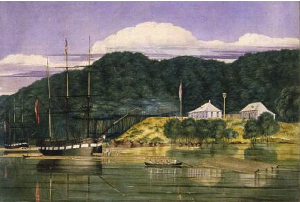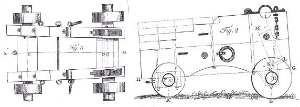Kohukohu Cannons
 By John Osborne -- AA, NCGM, DTT, FSG
By John Osborne -- AA, NCGM, DTT, FSG
These Kohukohu cannons have a history associated with George Frederick Russell (1809-1855).
Russell sailed from Sydney to Horeke in 1831 and purchased his Kohukohu properties in 1839 (including the property overlooking Kohukohu and the inlet (refer image below) and later owned by the Yarborough family) setting up his own business as a timber trader, shipping kauri spars and squared timber to London and other markets.
 Russell’s business rapidly expanded, Kohukohu succeeding Horeke as the centre of the Hokianga timber trade.
Russell’s business rapidly expanded, Kohukohu succeeding Horeke as the centre of the Hokianga timber trade.
This painting by Charles Heaphy c1839 is titled “Kahukahu” and is of George Russell’s house and a long boat towing squared kauri for loading and shipping.
Being “small in size and quick in movement” Russell was known to the Maoris as “Piwakawaka” (fantail).He married a close relative of paramount Maori Chief Tamati Waka Nene who did much to promote colonization and to establish Queen Victoria’s authority.
When George Grey was knighted he chose Nene (c1785-1871) as one of his esquires. Then when he returned to New Zealand for his second term of Governorship in 1860 he brought Nene a silver cup from Queen Victoria.
In 1845 Russell helped to supply arms and cannon to Nene and the Hokianga Maori War Parties opposing Chief Hone Heke. Kohukohu was in Ihutai tribe territory led by Chief Te Wharepapa who had sided with Heke.
Heke and Kawiti were only defeated once in the conflict at the Battle of Te Ahu Ahu on 12 June 1845, by Nene with no help from the British.
HMS Osprey, Captained by Fredrick Patten, then employed in the East Indies to locate and destroy pirate ships and shore bases was, following a request from Governor Robert Fitzroy, ordered to policing duties in war-threatened Northern New Zealand.
Patten’s orders were to show the flag in Hokianga and enforce a blockade of the Northland coast. Blockading included stopping foreign whalers from smuggling arms and ammunition into Northern New Zealand.
On arrival in Hokianga September 1845 Patten was for a short time the senior Naval Officer in New Zealand, he announced his intention of attacking the nearby Ihutai Pa (Fort). Russell called the European Settlers together and dissuaded Patten from action which would have jeopardized European lives and property and ended their neutrality in the Hokianga.
After the siege on Ruapekapeka Pa Heke and Kawiti, still unbeaten by the British were ready for peace and negotiated terms with Nene. Nene went to Auckland (then New Zealand's Capital) and told the Government the war was over.
Tamati Waka Nene died 4 August 1871 and is buried at Russell. The then Governor, George Bowen said that Nene did more than any other Maori to promote colonization and to establish the Queens authority.
One of Russell’s sons, Frederick Nene Russell, was elected unopposed as the first member of the New Zealand House of Representatives for Northern Maori.
After George Frederick Russell’s death in 1855 age 46 his Kohukohu business was carried on by John Webster who married Russell’s eldest daughter.
For many years these cannons stood overlooking the Town of Kohukohu in the garden of the Yarborough property.
After the death of Mr G. C. Yarborough J.P. on the 6th July 1969 the cannons were re-sited on their present position by the Hokianga County Council in recognition of the services given to the people of Hokianga by this family and in particular by the late Mr A. C. Yarborough who was the first chairman of the county from 1876 onwards and the late Mr A. G. C. Yarborough who was chairman from 1927 to 1952. (from the inscription on the bronze plaque at rear)
From 1716 the British cast iron barrel pattern was standardized by General John Armstrong, Chief Engineer to the Duke of Marlborough
 The figure on right (from a contemporary gunnery notebook), full size drawings and copper cores were sent to foundries. By about 1760 the British excelled in the refinement of iron, barrels were cast solid and bored out making them stronger and more accurate.
The figure on right (from a contemporary gunnery notebook), full size drawings and copper cores were sent to foundries. By about 1760 the British excelled in the refinement of iron, barrels were cast solid and bored out making them stronger and more accurate.
Cannon barrels were proved by double charging with powder and testing twice, this normally revealed any manufacturing flaws.
Improvement to gunpowder allowed a decrease in barrel length and barrel proportions were altered for strength, becoming thicker at the breech and lighter in the chase without adding extra weight.
The cannon design required the diameter and length of the side trunnions to be the same as the bore diameter.
 The figures on the right are the side elevation and plan of the Sea Service Truck (wheeled) Gun Carriage c1760.
The figures on the right are the side elevation and plan of the Sea Service Truck (wheeled) Gun Carriage c1760.
Captain James Cook employed this pattern and size of gun on the 10 gun HMS Endeavour during his Voyage of Discovery including New Zealand in 1768-1771
In 1780 Captain Thomas Blomefield was appointed Inspector of Artillery at Woolwich, London. Blomefield effected great improvements in inspection and manufacture. By 1830 it was established that well made British barrels were so strong they could be “Bored Up” enlarging the bore of a gun to the next or second higher caliber with a reduction in windage.
Note “Windage” means the clearance between the smaller diameter round ball projectile shot and the barrel bore.
Advantages:- this made the guns more efficient, more accurate and giving better penetration from 400 yards out.
Disadvantages:- greater recoil, some guns unsafe when double shotted, reduction in muzzle velocity with corresponding change in trajectory.
These 5 foot Kohukohu Cannons appear to be bored up two calibers from 4 pounders 3” bore (size of the trunnions) to 9 pdrs 4” bore. There is no provision to attach a flintlock igniter on the vent piece which was introduced during the 1790’s.
These two high quality guns appear to be made for private / merchant use.
Copyright retained by author reviewed 10 April 2006 research continuing.
History
For more information see:
Guns of HMS Osprey, by John Osborne 1985 .
Far North District Council www.fndc.govt.nz
An Encyclopaedia of New Zealand 1966 www.teara.govt.nz
Wikipedia, the free online encyclopedia www.wikipedia.org
Tamati Waka Nene www.fact-index.com
Royal Engineers Museum www.remuseum.org.uk
British Gunnery Note Book, c1760 author unknown www.gunsmithsociety.com

